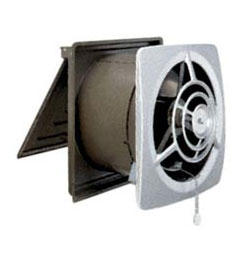As the name suggests, wall ventilation fans are exhaust systems that are located on wall sections within home areas. While most ventilation fans tend to be located on the ceiling, wall ventilation fans are instead fixed into the wall, either into a previously existing ventilation duct or one that is built later on. There are a variety of different ways to get a wall ventilation fan installed in your home, and there are even kits available that enable homeowners to install wall ventilation fans themselves. Learning more about wall ventilation fans and how they work will help you when it comes time to purchase one for your home.
Installing wall ventilation fans in your home
Installing a new ventilation fan on your wall is not difficult if there is an existing ventilation duct in place. This will be the case if you already had a wall fan set up and are simply looking to install a replacement (if the one you had broke down). On the other hand, if you do not have a duct system built into your wall, then it will be slightly more difficult to install a wall ventilation fan on your own. Here are some options:
- Build a duct system that allows air to be circulated from the exterior of your home throughout the area in which you intend to install your wall ventilation fans. The way to do this would be to cut a duct into a wall that has its opposite end on the exterior of your home. You can cut through the drywall and build a simple air duct from scratch.
- Alternatively, choose to hire a professional to install a new duct in your wall and build your wall ventilation fan into it. This is the option preferred by homeowners who might not have the energy or skill set needed to perform the task of wall ventilation fans themselves. Generally speaking, these services are quite easy to contract, and you should be able to find a company offering these kinds of services in your immediate area.
Purchasing new wall ventilation fans
As far as buying wall ventilation fans goes, you will have numerous options. Most of the major manufacturers of ventilation fans for ceilings, bathrooms, and attics offer their own range of wall ventilation fans for those who prefer wall-mounted systems to those built into the ceiling. A quick look at popular manufacturer catalogs belonging to Broan, Panasonic, AirKing, or NuTone should land you with a variety of viable prospects.
Wall ventilation fans - other things to know
Before you purchase any wall ventilation fans or make plans to install a new one in a wall without an existing air duct, you should take the time to consider the ventilation requirements of the room in question. Bathrooms and kitchens clearly require more air changes per hour for adequate ventilation than other areas of the home where humidity is not much of an issue. Depending on the size of these rooms you may also need a powerful fan capable of moving hundreds of cubic feet (of air) per minute.

- Home
- Air Ventilation Fans
- Attic Ventilation Fans
- Basement Ventilation Fans
- Bathroom Ventilation Fans With Light
- Bathroom Ventilation Fans
- Ceiling Ventilation Fans
- Centrifugal Ventilation Fans
- Commercial Ventilation Fans
- Crawl Space Ventilation Fans
- Ductless Ventilation Fans
- Electric Ventilation Fans
- Exhaust Ventilation Fans
- Fans For Ventilation
- Garage Ventilation Fans
- Greenhouse Ventilation Fans
- Home Ventilation Fans
- Industrial Ventilation Fans
- Inline Ventilation Fans
- Kitchen Ventilation Fans
- Portable Ventilation Fans
- Quiet Ventilation Fans
- Roof Ventilation Fans
- Room Ventilation Fans
- Shower Ventilation Fans
- Small Ventilation Fans
- Solar Attic Ventilation Fans
- Solar Ventilation Fans
- Ventilation Fans Bathroom
- Wall Mounted Ventilation Fans
- Wall Ventilation Fans
- Window Ventilation Fans
